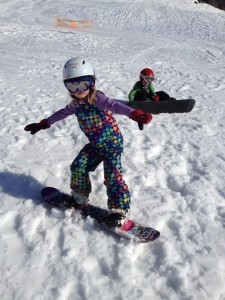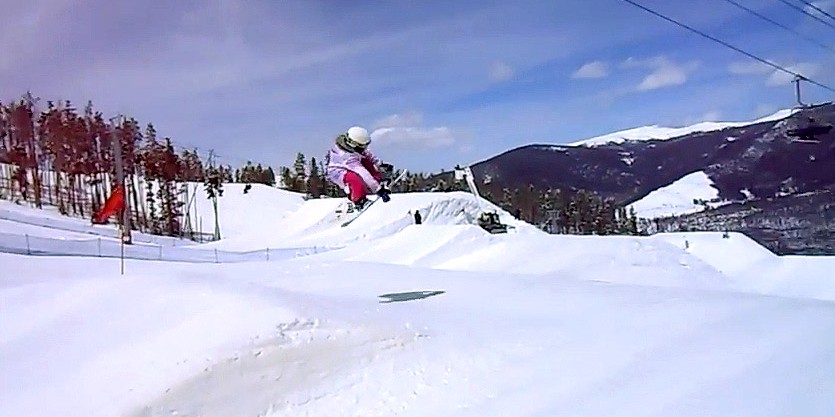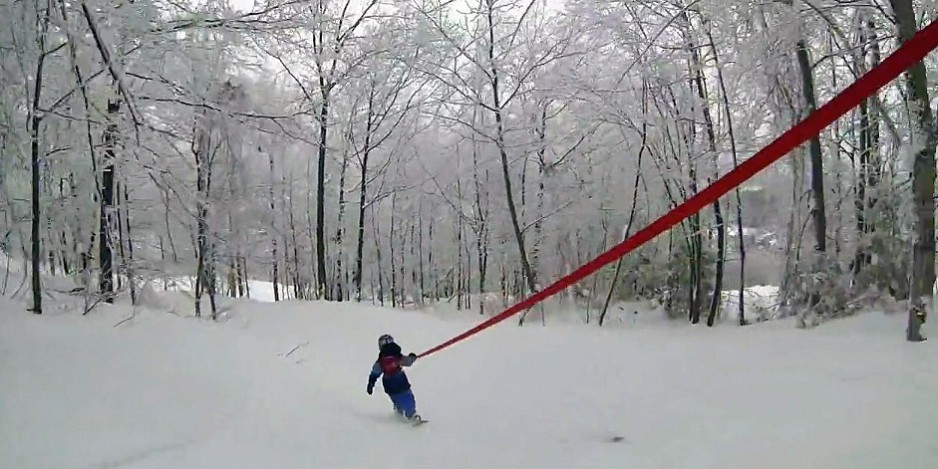Most six year old’s have the ability to learn the snowboard basics within a week. Although it may take a few days for them to find their feet, after a week – if you’re lucky – you may have a fully fledged snowboard grom on your hands!
General Guidelines
Think about focusing on fun and encouraging efforts whilst instilling control, safety and basic techniques.
 What to expect / Likely progression
What to expect / Likely progression
Within a week or so, it is very possible for your six year old to be able to ride independently down a slope, with heel and toe edge turns, stopping and having control.
They may also be on their way to coming off lifts without falling over and be keen to try their first bit of freestyle or shallow powder!
However, some may need more time and patience to get to this stage.
They may favour their heel edge (think of it as the snowboarding equivalent of snow-ploughing!) and most will be working on the consistency and control of their turns.
Some may lack technique (often the boys!), favouring the gun-ho straight-down-the-hill method whereas others (often the girls!) favour being more in control so they may be more technical but steadier.
If your child has longer than a week to learn, or if you have the luxury of being mountain-based then you can expect amazing progress. Again, the start will be slow but the progress will soon be rapid!
Perks…
- At this age they are able to cope with longer sessions, which will increase their progression.
- You should find it easier to source correctly sized equipment for a six year old.
- They may progress really quickly = lots of fun!
- The earlier they start the easier it gets as they get older and the quicker their progression.
- Most ski/snowboard schools would offer private snowboard lessons for a six year old.
Remember that the first few days progress may be very slow, this is totally normal! Keep going and keep encouraging; you will tend to see more progress towards the end of a week rather than gradually over a week.
& Pitfalls…
- They may take longer than you’d like to get their confidence and/or technique down.
- They may struggle with the cold/equipment/lessons (especially if group lessons).
- You may not find any appropriate instructors.
- Chairlifts and button lifts can be a big challenge at first.
- You will probably have to sacrifice a fair bit of your own riding time to get your kids up and running! (This is all worth it, however …eventually!)
How to – Practical advice and Tips
Pre-Snow
Get them used to the equipment if you can:
- Try on a snowboard, boots & bindings, helmet & goggles and even all their winter clothing. This should get them excited too!
- Show them how to strap into their bindings and get them to practice clipping in and un-clipping with gloves on.
- Letting them stand and jump around on the board. Make sure it’s on carpet or grass or somewhere the board won’t get damaged or it’s edges damage surfaces, furniture etc!
- Explain as an introduction, what the basic parts of the board and bindings are called – ie. nose, tail, heel & toe edges.
- Introduce some basic snowboarding techniques – eg. ask the kids to stand sideways and practice looking and pointing in the direction they want to go or explain a little about edges.
- Hopefully all this will help the board feel more familiar when they try it on snow.
- Keep it fun – don’t get bogged down with anything too technical!
Lessons?
Most ski/snowboard schools will offer snowboard lessons for six year old’s. If your child is keen, lessons with a qualified SNOWBOARD instructor are a great idea. You may struggle to find group lessons at this age – but it is actually a great idea for them to have private one on one lessons (or one on two if they are learning with a friend) initially – they will really benefit.
From around this age kids are capable of much longer stretches riding. A full day would probably have to be broken up with lots of breaks however (although each child is different – some may want to stay out all day, others may only last a couple of hours). And remember that learning any new sport is waaaaay harder and more physically exhausting than if you can do it already! So they will get tired out!
Technical Info Bit!
Kids have a different centre of gravity, head weight and muscle mass than adults so often when they learn to snowboard they do so a little differently.
When they start to learn to control a snowboard, don’t worry if they use use slightly different body positions to adults. For example, they may rely more on their heel edge and they may lean over their back foot more in order to find their balance and complete movements – this is all very normal for young children.
As children learn, grow and adapt, their riding will change, so don’t panic if they’re not stylin’ it initially – it won’t be long until they’re out riding you!
(See more in our ‘Technical Advice’ Section)
Even if your child is having lessons there will undoubtedly be times when you will be on the slopes with them. And it is very possible that their first experience on snow will be with you. So here are a few helpful hints and tips to hopefully make for a smooth introduction to snowboarding!
First techniques
- If you are able to put your child into a lesson with an instructor trained in teaching children (see our Snowboard Schools Guide) then that is generally the best way to go. However, availability, price, timing and child temperament means that this is not always a viable option. The following are a few techniques you can use to help teach your child or build on what they have already been taught:
- Initially you can start by introducing them to all the parts of the board – heel & toe edge, nose & tail etc.
- Ask them to strap their leading foot in and attempt ‘scooting’ (do this either on the flat or somewhere very flat) ie. pushing off with the no-strapped in foot and then placing the foot infront of the back binding so they glide with the momentum of the push with the foot with both feet on the board.
- Stood on the flat, with both feet strapped in, they can attempt jumping straight up and down, landing flat on the base of their board.
- If they move up a slope a little you can help them get up and then they can initially move onto riding and gliding on the flat of the board sideways between parents
- When they are confident with this you can hold their hands and introduce moving on their heel edge. This may take a bit of practice – remind them to lift their toes up and look ahead not at their feet!
- You can then integrate those two techniques – the sliding on the flat going straight and the heel edge technique by introducing a heel edge turn to stop.
- To help with this technique, hold their hands at first and walk them through it but also encourage a good body position (not leaning back, knees bent, not bent over) and tell them to look and point where they want to go – moving and following their body to turn the board.
- You could also walk them through some heel and toe turns – this will introduce them to toe edges and the concept of turning too.
- To mix it up, if you are confident in your riding, you could also ride with your child – holding their hands/arms – going through heel and toe turns
- Keep things fun – introduce one thing at a time!
- Try to work towards getting them to stop of their own accord. So ask them to follow their hand and pointing in the direction they’d like to go. This may not come for a while or with much control initially, so go at their pace and keep encouraging them.
- They can practice flipping themselves and their board over from sitting (facing down the slope) to getting up from their knees (facing up the slope). This is good for encouraging autonomy and for using toe edge. However, bear in mind this technique can be tiring for them and they will need a little help at first!
- From the start it is also a good idea to instill in them a few useful snowboarding and snow slope etiquette/rules. For example; always put your board bindings-side down when you put it on the ground; try and keep a hold on your board/bindings whilst strapping in; try and get to the sides of the slope if you need to stop; don’t stop in the middle etc. This sort of information may or may not go in, but it’s worth saying and then repeating! (See our section on Safe Snowboarding for more info)
- If they are struggling on their toe edge (which is normal for younger children) try holding their hand or hands whilst they are on their toe edge and walking them through toe to heel turns. Eventually get them to try this on their own. It’s a good confidence builder when they are able to complete it independently. It’s also helpful for getting them up from the ground independently particularly as it can be harder to get up facing down the hill especially on lower gradient slopes.
- Remember that learning initially is really about the kids getting comfortable on their boards, not rapid progression.
- Also remember that they don’t need instruction all the time. With patience, mileage and time they will soon be ripping around on the snow!
Regular or Goofy?
Whether your child is regular or goofy – ie. if they lead with their left foot forward (regular) or the right (goofy) – may not be apparent straight away. Most kids boards are a twin tip design, meaning they can be ridden either way. So initially try one direction but don’t worry if they seem to favour the other foot or direction, because it’s a twin tip it should ride fine either way – you can change their set up accordingly later. Don’t be tempted to go really ‘duck footed’ (ie. both toes really angled outwards) as this won’t be helpful with their balance.
You can try a couple of methods to ascertain which foot they will lead with; stand behind them and give them a tiny push or tell them to imagine running up to a patch of ice and skidding; with both of these, the foot they put out first will be their leading foot – although obviously neither of these methods are foolproof!
Which Slopes?
Choose an easy, quiet, safe slope with a very gentle incline at first if you can. This doesn’t have to be a designated ‘beginner area’ initially; anywhere quiet, snowy (use caution or choose another day or slope if it’s icy) with a low gradient. After they get more comfortable on a slope, don’t be afraid to move to a onto something a little steeper if the first place you try has a particularly low incline, as having a little bit of speed will definitely help them get a feel for the boards movement and ultimately help initiate smoother turns.
Advice on Lifts
It’s great if you have access to an easy slope with a travelator, rope tow or even an easy chairlift – brilliant fun for the kids and less exhausting for Mum & Dad!
Button lifts and T-bars can be tricky and may take a little practice. However, most beginner areas will usually have easier, slower lifts with, hopefully, patient lift attendants!
Chairlifts can also be tricky, think about keeping both your childs feet strapped in at first and make sure you are able to lift them on and off. Go through ‘what happens if I fall’ with them – ie. move out of the way as soon as you can & look out for the chairlifts swinging around and clonking you on the head!
Every lift is different so use your judgement on what will work best.
On button lifts we found that if our daughters kept both feet strapped in, made sure they kept their trailing arm pointing down the slope and looked upwards to where they were going they had much more success. They loved the independence!
What to wear?
Layers are best – good for keeping warm, easy to take off when they get hot. ‘Bibbed’ dungaree style snowboard pants and all-in-ones are good – they keep the snow out and there’s always lots of bending and rolling about when kids and snowboarding are involved. Toilet stops can take a bit longer however!
Always make sure they have good, waterproof gloves. Kids ski gloves tend to have less waterproof covering on the palms because you have your hands on the snow a lot less when you are skiing as opposed to snowboarding, so be aware of how waterproof any gloves they have are.
Also a good warm helmet and goggles too. Keep sunglasses and a beanie handy for when they stop as they may want to take off their helmet & goggles. A cold child will most likely be a miserable child!
Other than a helmet, any extra body protection is up to you. At first, lots of bulky body armour is likely to impede their movement – so not ideal for learning. However as they get a lot better you may need to think about back protectors, knee & elbow pads, impact shorts and wrist guards. This is a personal choice and they will probably only need to be seriously kitted about when they are thinking about hitting boxes and jumps or if they are really seriously kamikaze!
Equipment
90-110cm board (they can go smaller or larger depending on size and height of child see our Snowboards Guide for more info).
At this age there now tends to be more choice of kids boots and you should be able to find appropriate rental equipment in a lot of places. If you are renting make sure your child’s board is of a newer design (ie. rocker or flat etc).
They shouldn’t need a harness at this age but gentle slopes and easy lifts for the first few times.
See our Equipment Guide for more info.
Below are two short clips of two six year old’s snowboarding. To watch more check out our Age 6 videos in our video section – these show lots of six year old’s riding, some are just beginning, others have had some practice. Also have a look at the Kids Who Ride section on our Videos page.





